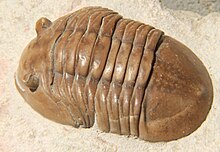Asaphidae
| Asaphidae Temporal range:
| |
|---|---|

| |
| Asaphus latus | |
| Scientific classification | |
| Domain: | Eukaryota |
| Kingdom: | Animalia |
| Phylum: | Arthropoda |
| Class: | †Trilobita |
| Order: | †Asaphida |
| Superfamily: | †Asaphoidea |
| Family: | †Asaphidae Burmeister, 1843 |
| Subfamilies[1] | |
Asaphidae is a family of asaphid trilobites. Although the first genera originate in Upper Cambrian marine strata, the family becomes the most widely distributed and most species-rich trilobite family during the Ordovician. 754 species assigned to 146 genera are included in Asaphidae.
Distribution
[edit]Most Asaphinae are characteristic of Baltica. Isotelinae genera are concentrated in Laurentia. The genera of Nobiliasaphinae are distributed in tropical Gondwana and South China. The genera of Ogygiocaridinae occur in Avalonia, Gondwana and Baltica. Asaphidae asaphids were already fairly common during the Upper-Cambrian, when 14 genera are known from Australia, North- and South-China. The last members of the family died-out at the end of the Ordovician.[2]

Assigned genera
[edit]
Asaphidae contains the following genera:[3]
- Anataphrus
- Araiocaris
- Asaphellus
- Asaphus
- Atopasaphus
- Aulacoparia
- Aulacoparina
- Australopyge
- Baltiites
- Banqiaoites
- Basilicus
- Bellefontia
- Birmanitella
- Birmanites
- Bohemopyge
- Borogothus
- Brachyaspis
- Branisaspis
- Burminresia
- Charabaia
- Chengkouella
- Dubovikites
- Ectenaspis
- Ekeraspis
- Emanuelaspis
- Emanuelina
- Eoasaphus
- Eoisotelus
- Erdelia
- Estoniites
- Fuyunia
- Gerasaphes
- Gog
- Gogiura
- Golasaphus
- Griphasaphus
- Guohongjunia
- Hazarania
- Heraspis
- Hoekaspis
- Homalopyge
- Hunjiangites
- Hunnebergia
- Huochengia
- Iduia
- Isabelinia
- Isotella
- Isoteloides
- Isotelus
- Isyrakella
- Isyrakopeltis
- Kainisiliellina
- Kayseraspis
- Klabavia
- Kobayashia
- Lachnostoma
- Lamanskytes
- Lapidaria
- Leningradites
- Liomegalaspides
- Lisogorites
- Liushuicephalus
- Lonchobasilicus
- Lycophron
- Megalaspidella
- Megalaspides
- Megasaphus
- Megatemnoura
- Megistaspidella
- Megistaspis
- Merlinia
- Metaptychopyge
- Metayuepingia
- Mioptychopyge
- Mischynogorites
- Nahannia
- Neopeltis
- Nerudaspis
- Nileoides
- Ningkianites
- Niobe
- Niobella
- Niobides
- Niobina
- Nobiliasaphus
- Norasaphites
- Norasaphus
- Norinia
- Notopeltis
- Ogmasaphus
- Ogyginus
- Ogygiocarella
- Ogygiocaris
- Ogygitella
- Ogygites
- Ogygitoides
- Onchometopus
- Parabellefontia
- Paramegalaspis
- Paramegistaspis
- Paraptychopyge
- Paratamdaspis
- Parayuepingia
- Penchiopsis
- Platyptychopyge
- Plectasaphus
- Plesiyuepingia
- Popovkiaspis
- Popovkites
- Praecoparia
- Presbynileus
- Priceaspis
- Proasaphus
- Promegalaspides
- Protopresbynileus
- Protoptychopyge
- Proxiniobe
- Pseudoasaphinus
- Pseudoasaphoides
- Pseudoasaphus
- Pseudobasilicoides
- Pseudobasilicus
- Pseudobasiliella
- Pseudobasiloides
- Pseudogriphasaphus
- Pseudogygites
- Pseudomegalaspis
- Pseudoptychopyge
- Pseudoptyocephalus
- Psilocephalina
- Psilocephalops
- Ptychopyge
- Ptyocephalus
- Rhinoferus
- Sanbernardaspis
- Shergoldina
- Stegnopsis
- Stenorhachis
- Suriaspis
- Tchukeraspis
- Thysanopyge
- Trigonocerca
- Trigonocercella
- Tsaidamaspis
- Valdaites
- Vogdesia
- Volchovites
- Xenasaphus
- Xenostegium
- Xinanocephalus
- Yuepingioides
- Zhenganites
- Zoraspis
- Zuninaspis
References
[edit]- ^ Bell, Mark A.; Braddy, Simon J. (2011). "Cope's rule in the Ordovician trilobite family Asaphidae (order Asaphida): patterns across multiple most parsimonious trees". Historical Biology: 1–8. doi:10.1080/08912963.2011.616201. S2CID 84438297.
- ^ J.M. Adrian (2014). "20. A synopsis of Ordovician trilobite distribution and diversity". In D.A.T. Harper; T. Servais (eds.). Early Palaeozoic Biogeography and Palaeogeography. Memoirs of the Geological Society of London. Vol. 38. Geological Society of London. p. 490. ISBN 978-1862393738.
- ^ S. M. Gon III. "Order Asaphida". Archived from the original on 6 January 2011. Retrieved December 7, 2010.
Links
[edit]- "Drawings of many asaphids". Problems of evolution. Archived from the original on January 3, 2014.
